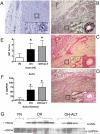Advanced glycation end products accumulate in vascular smooth muscle and modify vascular but not ventricular properties in elderly hypertensive canines
- PMID: 18711013
- PMCID: PMC2753480
- DOI: 10.1161/CIRCULATIONAHA.108.777326
Advanced glycation end products accumulate in vascular smooth muscle and modify vascular but not ventricular properties in elderly hypertensive canines
Abstract
Background: Advanced glycation end products (AGEs) are believed to increase left ventricular (LV) and vascular stiffness, in part via cross-linking proteins. We determined whether and where AGEs were increased in elderly hypertensive nondiabetic dogs and whether an AGE cross-link breaker (ALT-711) improved vascular or ventricular function.
Methods and results: Elderly dogs with experimental hypertension (old hypertensives [OH]) were randomized to receive ALT-711 (OH+ALT group; n=11; 1 mg/kg PO) or not (OH group; n=11) for 8 weeks. Conscious blood pressure measurements (weekly), echocardiography (week 8), and anesthetized study (week 8) with LV pressure-volume analysis and aortic pressure-dimension and pressure-flow assessment over a range of preloads and afterloads were performed. In LV and aorta from OH, OH+ALT, and young normal dogs, AGE content (immunohistochemistry and Western analysis for N(epsilon)-(carboxymethyl)lysine [CML]) was assessed. Aortic CML content was markedly increased in OH and OH+ALT dogs compared with young normal dogs. CML was localized to aortic and aortic vasa vasorum smooth muscle but not to collagen or elastin. CML was essentially undetectable in young normal, OH, or OH+ALT myocardium but was visible in large vessels in the LV. ALT-711 therapy was associated with lower blood pressure and pulse pressure, decreased systemic vascular resistance, increased aortic distensibility and arterial compliance, and, notably, significant aortic dilatation. Neither LV systolic nor diastolic function was different in OH+ALT versus OH dogs.
Conclusions: In elderly hypertensive canines, AGE accumulation and AGE cross-link breaker effects were confined to the vasculature without evidence of myocardial accumulation or effects. The lack of AGE accumulation in collagen-rich areas suggests that the striking vascular effects may be mediated by mechanisms other than collagen cross-linking.
Figures






Comment in
-
Letter by Hartog et al. regarding article, "Advanced glycation end products accumulate in vascular smooth muscle and modify vascular but not ventricular properties in elderly hypertensive canines".Circulation. 2009 Mar 17;119(10):e233; author reply e234. doi: 10.1161/CIRCULATIONAHA.108.826966. Circulation. 2009. PMID: 19289645 No abstract available.
References
-
- O'Rourke MF, Nichols WW. Aortic diameter, aortic stiffness, and wave reflection increase with age and isolated systolic hypertension. Hypertension. 2005;45:652–8. - PubMed
-
- Mitchell GF, Conlin PR, Dunlap ME, Lacourciere Y, Arnold JM, Ogilvie RI, Neutel J, Izzo JL, Jr., Pfeffer MA. Aortic diameter, wall stiffness, and wave reflection in systolic hypertension. Hypertension. 2008;51:105–11. - PubMed
-
- Kass DA. Ventricular arterial stiffening: integrating the pathophysiology. Hypertension. 2005;46:185–93. - PubMed
-
- Smit AJ, Lutgers HL. The clinical relevance of advanced glycation endproducts (AGE) and recent developments in pharmaceutics to reduce AGE accumulation. Curr Med Chem. 2004;11:2767–84. - PubMed
-
- Soldatos G, Cooper ME. Advanced glycation end products and vascular structure and function. Curr Hypertens Rep. 2006;8:472–8. - PubMed
Publication types
MeSH terms
Substances
Grants and funding
LinkOut - more resources
Full Text Sources
Medical

